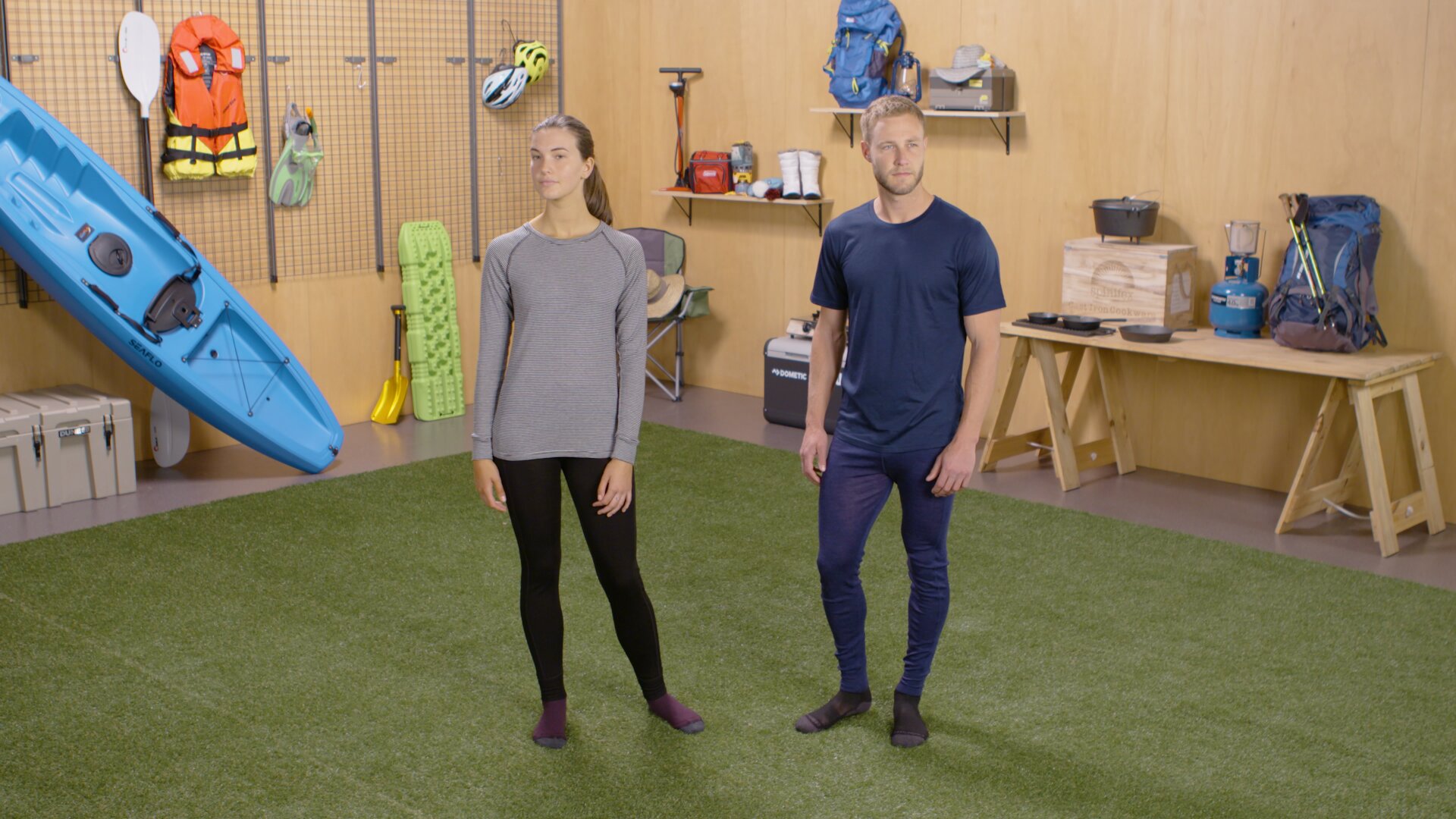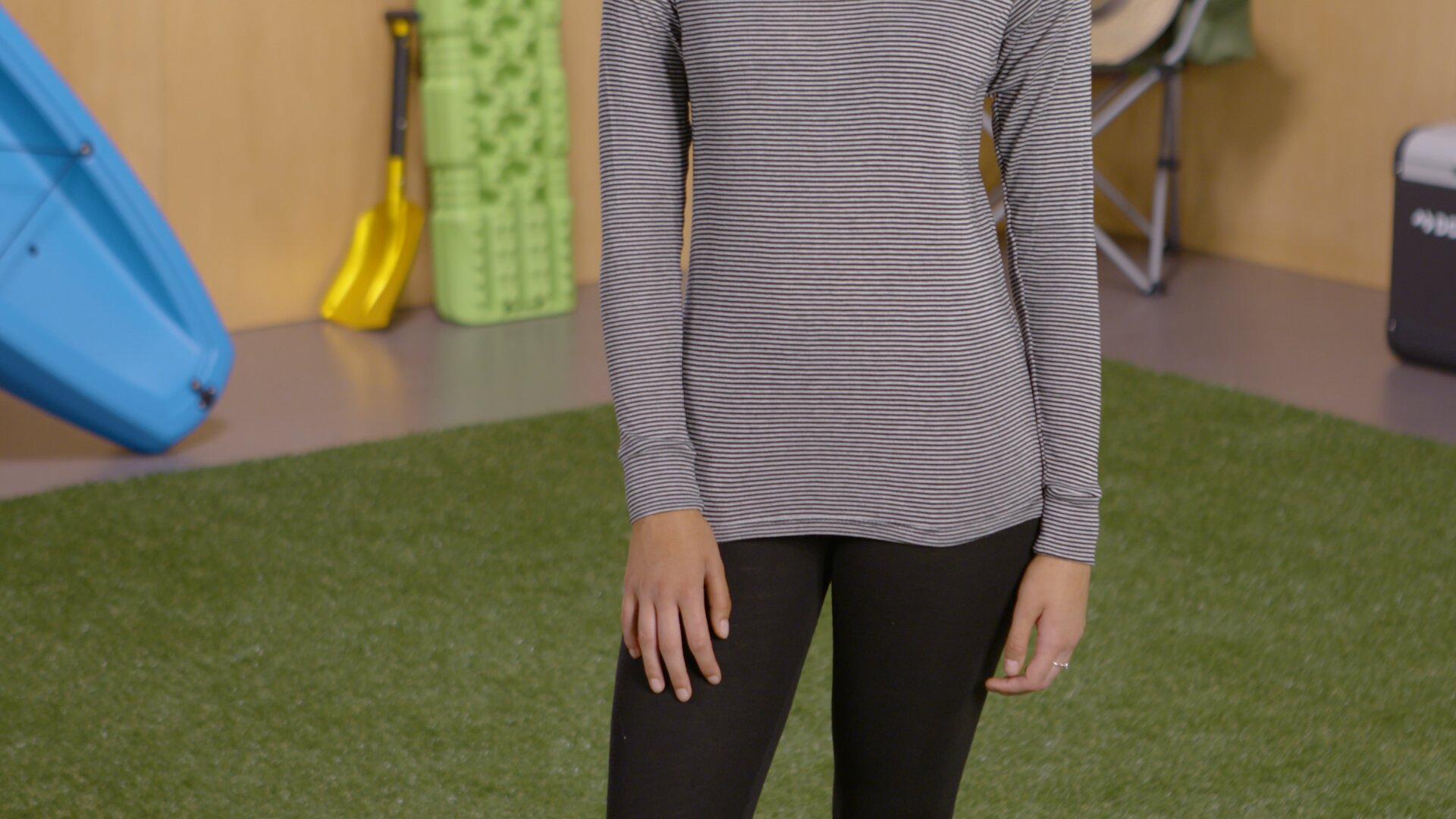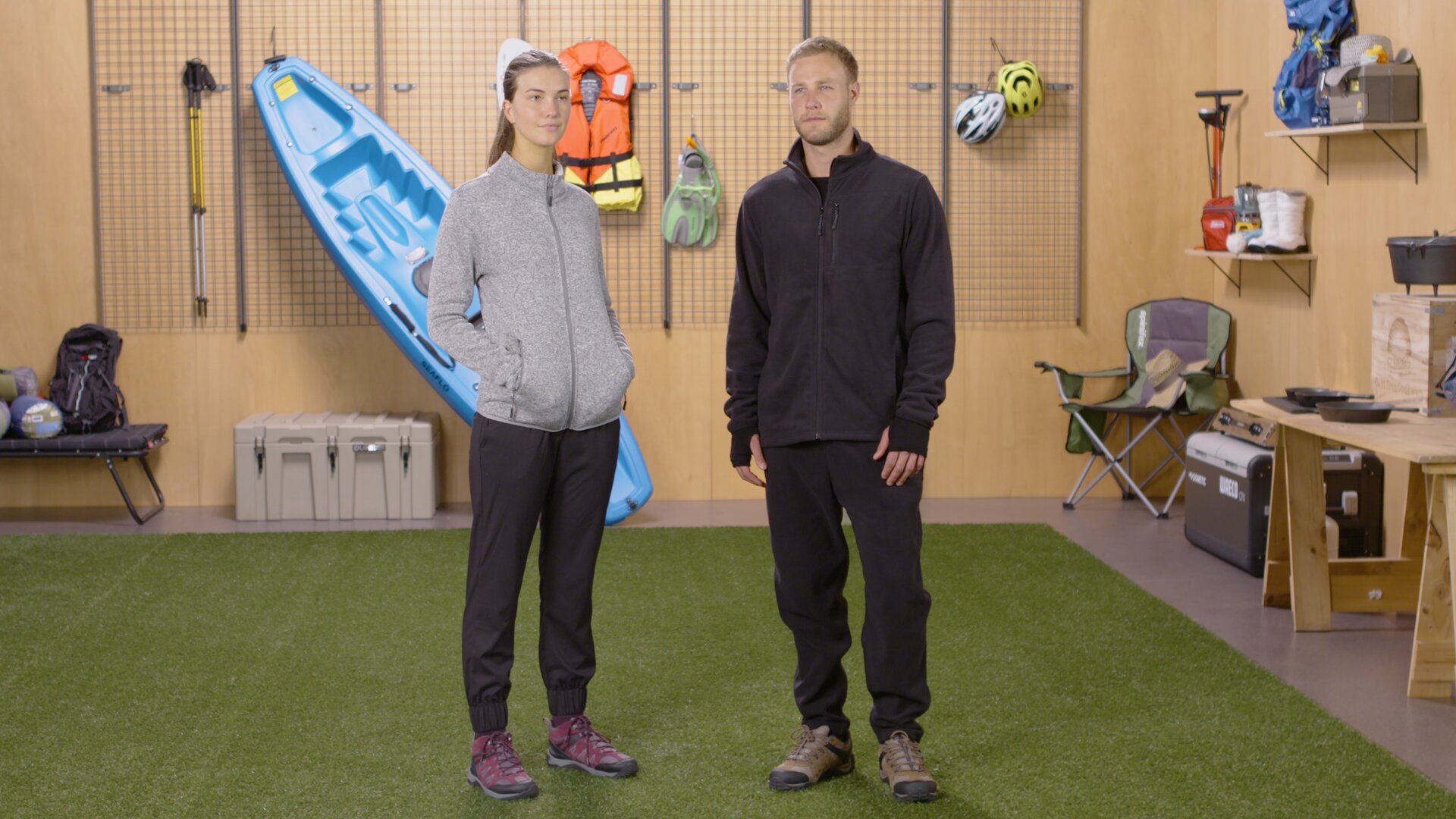| Your browser is not supported. | ||
|
Please browse our site using any of the following options:
| ||
Base Layer Buying Guide
Whether you're hitting the slopes, camping, hiking or travelling in chilly conditions, you'll need the right clothing to ensure you're warm and happy, not cold and miserable. Wearing layers is the key to staying warm and comfortable, and this buying guide outlines the importance of wearing a base layer. When you get dressed you put your thermals on first. Their job is to help keep your body warm, drawing moisture away from your skin so your sweat or standing still doesn't make you feel cold. This ensures your body temperature is comfortable in mild and ultra-cold conditions.
Quick Links
- Base Layer FAQs
- What's The Best Base Layer?
- Layering Basics
- Fit & Type
- The Materials Of Your Base Layers
- Activity & Conditions
- The Quality Of Your Base Layers
Base Layer FAQs
What Are Thermals?
Thermals in clothing refer to insulating garments designed to retain body heat and keep wearers warm in cold conditions. Made from materials like wool, polyester or specialised fabrics, thermals include base layers such as tops and leggings. They are essential for outdoor activities in winter, providing warmth without bulk by trapping air close to the body.
How Do Thermals Work?
A thermal base layer works by trapping body heat and minimising heat loss. Made from insulating materials like wool or synthetic fibres, these garments create a layer of warm air next to the skin. They wick moisture away, keeping the wearer dry and warm. Thermal clothing is typically worn as a base layer to maximise heat retention in cold weather.
How Tight Should Thermals Be?
Thermals should fit snugly against the skin without being too tight. A close fit ensures optimal heat retention and moisture-wicking while allowing flexibility and comfort. They should not restrict movement or circulation. Properly fitted thermals trap body heat efficiently, enhancing warmth and comfort during cold weather activities.
What Are Thermals Made From?
Thermal clothing is made from insulating materials like wool, polyester and specialised synthetic fabrics. Wool offers excellent warmth and moisture-wicking properties, while polyester and synthetics provide lightweight, durable and quick-drying benefits. These materials trap body heat, wick away sweat and ensure comfort in cold weather, making them ideal for base layers and outdoor activities.
What Are The Warmest Thermals?
The warmest thermals are crafted from high-grade merino wool and advanced synthetic blends. Merino wool excels in warmth, moisture-wicking, and natural odour resistance. Advanced synthetic materials, combining polyester and spandex, offer superior insulation, breathability and quick-drying properties. These materials are engineered to provide maximum heat retention and comfort in extreme cold, ensuring optimal thermal performance.
What's The Best Base Layer?

When you're trying to work out which thermals will be best for you or the kids, remember that what's best for one person might not suit someone else. Choosing the best base layer comes down to each individual's unique needs and preferences:
- The conditions you expect to face now and in future (what temperatures and will this vary?)
- How much you feel the cold in general (if you're always cold go for the warmest thermals)
- How often you'll be outside wearing your base layer (once a year or most weekends?)
- How active your adventures will be (will you be walking or working up a serious sweat?)
- How long you want your thermals to last (for one hike or ski season or for years to come?)
Layering Basics
When you're skiing, snowboarding, hiking, camping or kayaking, it's best to wear three layers:
A Base Layer
This layer will keep you dry and stop body moisture making you feel cold. It should draw (or wick) sweat away from your skin to keep you dry throughout the day. The result of this will stop body heat from escaping via your sweat so you feel warm. Another benefit is that it will also help to prevent excess moisture from causing chafing and blisters while you are enjoying your outdoor adventure.
A Middle Layer
The middle layer section will keep you nice and warm by stopping body heat from escaping, which is exactly what you want when doing outdoor activities in the harsh coldness of winter. It's put on after your thermals (base layer) and before your waterproof layer (outer layer). The middle layer will act as insulation by trapping in any heat that has escaped past your thermals.
An Outer Layer
And lastly, the outer layer will shield you from the elements you're exposed to such as wind, rain and snow, and is the last layer is the final frontier to ensure you're dry and warm. Some jackets and pants are all-in-one outer layers and middle layers, which is great depending on what outdoor activity you are doing. Any time you're inside you can shed layers, and then layer up before heading out again.
However, this buying guide is all about the base, the skin-tight layer you put on first to regulate your core body temperature so you don't feel too hot or too cold, but just right. For more information, check out our What Clothes & Shoes To Wear Winter Hiking article for more detailed information on how to master the art of layering your clothing.
Why Bother Wearing A Base Layer?
Let's take a closer look at how wearing thermals helps you combat the cold and be comfortable. Our bodies sweat when we're active to release heat (because water is really good at conducting heat) so we don't overheat. The problem with that is when it's windy or cold, this can cause our core body temperature to drop quickly, and even dangerously, and hypothermia is a serious risk in cold conditions. Wearing a thermal base layer absorbs the moisture your body releases, wicking it away from your skin before it has a chance to cause your body temperature to drop. The moisture then makes its way through the next two layers and evaporates. So in a nutshell, wearing thermals will stop your body heat escaping via your sweat, keeping the cold at bay so you stay warm.
To effectively regulate your core body temperature, the base layer needs to be:
- Hydrophilic: The technical word for absorbent, so it absorbs your sweat fast.
- Hydrophobic: The technical word for quick-drying, so wet fabric doesn't make you cold.
- A snug fit: That feels like a second skin, but not so tight that it restricts your circulation!
Fit & Type

Your thermals need to be the right fit for your body, and the type needs to suit the conditions. Thermals need to sit close to your skin to be able to wick moisture and trap heat for maximum dryness and warmth, choose a snug-fitting size (but not too tight). They should feel tighter than a t-shirt - any looser and they won't do their job. You can also get thermals with extra features so they're more comfortable:
- Flat-locked seams: Stitching that sits flat against your skin to prevent rubbing and chafing.
- High, mid or low-rise waists: For temperature regulation and your preferred comfort.
- An elastic waistband: Feels more secure around your middle and is great for climbing.
- Gussets: Extra padding on your underarms or inner thighs for comfort and mobility.
The type you choose depends on the weather conditions you'll face.
Sleeveless Vest
A sleeveless vest gives your arms more freedom to move but is not as warm as a thermal top with sleeves. It offers core warmth without adding bulk to the arms, making it an excellent base layer. Its streamlined fit enhances mobility and layering efficiency, ideal for fluctuating temperatures, and it's this versatility that makes it a sophisticated and practical choice for outdoor adventures.
Short Sleeves
Short sleeves make an excellent base layer due to their balance of comfort and versatility. They provide coverage while allowing for breathability and freedom of movement, and also keep your core warm and dry but you won't get too hot, so they are best for warmer weather. They're ideal for layering, short sleeves minimise bulk and enable effortless pairing with outer garments. Their adaptability suits various climates and styles.
Long Sleeves
Long sleeves are an outstanding base layer for their warmth and comfort. They will keep the full length of your arms and legs warm, so they are best for cold conditions. They provide full-arm coverage, which is essential for insulation in cooler temperatures. Their snug fit design aids in moisture-wicking and layering without adding bulk. And lastly, they are ideal for diverse climates, ensuring a polished look and functional foundation for your next outdoor adventure.
The Materials Of Your Base Layers

The material the base layer is made from determines how warm, dry and comfortable you'll be. Materials can be natural, synthetic or a mixture of both, and each fabric has different benefits.
Synthetic Materials
Thermals are made from synthetic, man-made fabrics like polyester and provide a lot of warmth and will dry fast, making them ideal for snow and winter activities. Synthetic materials can start to smell as your body odour seeps into the fabric, however, some have an antibacterial treatment to help with odours.
Polypropylene
Polypropylene, which is often shortened to polypro, is an ultra-comfortable, extra-warm engineered polyester that's superior to old long johns. Polypro is hydrophobic so when sweat moves away from your body and into the fabric, it dries fast. It also wicks skin moisture away but only absorbs 1% of its weight before you feel damp and cold. Polypro is thin and lightweight (70% lighter than wool) so is great for layering without adding bulk, and is extremely hard-wearing so polypro thermals last a while and are easy to wash and dry quickly.
Natural Materials
Thermals made from natural fabrics like merino wool are breathable so they'll keep you at a comfortable body temperature in cold and warm weather. It provides better all-round comfort than thermals made from synthetic materials. Absorb more moisture than synthetic materials, but it will take longer to dry. And lastly, they don't absorb odours so you can pack light for camping and hiking trips without washing.
Merino Wool
Base layers made from merino wool are natural, breathable, warm and lightweight so they feel nice to wear. Because the outer surface is hydrophobic and the inner surface is hydrophilic, it will actually create a microclimate, protecting you from weather changes and ensuring that you are always comfortable. It's also hygroscopic, meaning it can absorb skin's moisture vapour and release it all at once. Merino wool thermals absorb up to 35% of its body weight in moisture before feeling damp, making it perfect for outdoor winter activities such as snowboarding, hiking, camping and skiing. It will still keep you warm even when wet (but take longer to dry than polypro), and is antimicrobial, meaning it will kill odour-causing bacteria during hiking and other high-energy activities. It's an extra fine fabric so it feels lovely and soft against your skin while keeping you warm, and the higher the wool density (thickness in g/m2), the warmer the fabric will make you feel.
Cotton
Cotton absorbs so much moisture it would make you feel cold, so it's not a viable base layer option for hiking and active adventures.
Synthetic & Natural Materials
Base layers made from a blend of polypro and wool combine the benefits of both materials, meaning they maximise warmth, breathability and dryness.
Sun Protection
Fabrics with a UPF50+ treatment will protect your skin from the sun's rays, particularly if you're wearing your thermals by themselves in warm weather.
Activity & Conditions
Choose what to wear based on what you're doing and the weather conditions.
Activity Intensity
The more active you'll be in your gear, the more important its breathability is. If the fabric doesn't breathe, the moisture leaving your body has nowhere to go so you'll feel hot and sweaty, and your clothes can become a bit stinky.
The thermals you wear need to suit the type of activity you're doing:
- A lightweight base layer: Best for stop-start activities like skiing or climbing.
- Heavier thermals: Best for just camping and walking around in cold weather.
- Merino wool: Best for low-moderate activities in the cold - warm and won't get smelly.
- Polypropylene: Best for high-intensity activities like cross-country skiing and running.
- Long hiking trips: Merino base layers are the best - they suit all temperatures and are odour-resistant.
- Bush hiking: Be aware that merino wool is super fine so may tear if it snags on trees etc.
Weather
The fabric thickness of your thermals needs to suit the weather you'll encounter:
- Mild weather: A lightweight base layer is best for warmer weather.
- Cold weather: Heavier thermals are better when it's extremely cold.
The Quality Of Your Base Layers

When you're weighing up which thermals to buy, think about quality versus cost. Synthetic fabrics like polypro are cheaper than natural fabrics like merino wool, but merino wool costs more than polypro because it's warmer, breathable and won't smell. Keeping the kids warm and dry with a high-quality base layer will keep them happier in the snow for longer, so it's a big win for parents. When it comes to how much you should spend on buying your base layer, think about how long you want it to last/how long it'll fit your kids for. If you won't be using your thermals often, buying a basic base layer will do the trick. If you're keen on lots of hiking and outdoor adventures, it's worth investing in high-quality thermals that will be comfortable and last years to come.
Find The Best Base Layers At Anaconda Today
Follow our helpful guide to base layers and you will ensure that you and your family stay warm and comfortable during your next winter outdoor adventure. Make sure you also check out our Adventure Centre for more helpful tips and exciting destinations that you can visit with your friends, loved ones and family. If you liked our Base Layer Buying Guide, then you might also like some of our other articles for awesome destinations and tips such as:
- Winter Camping Tips: How To Stay Warm While Camping In Winter
- Australia's Best Winter Camping Spots
- Wonderful Winter 4WDing Experiences Across Australia
- What To Consider When Going To The Snow For The First Time
Find your local Anaconda store and check out our extensive clothing and snow range for your next outdoor adventure